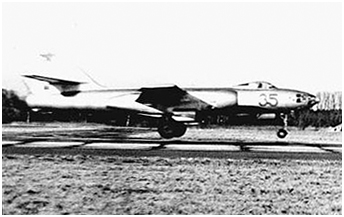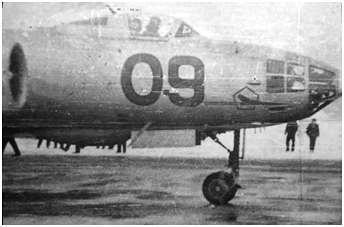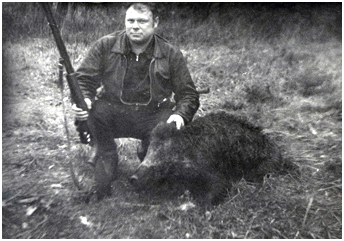The 1980s
 La côte de la Mer Baltique vue depuis un Il-28 du 65.OBAE en 1985. © O.Kozlov.
La côte de la Mer Baltique vue depuis un Il-28 du 65.OBAE en 1985. © O.Kozlov.
The Baltic Sea shoreline seen from an Il-28 of the 65.OBAE in 1985. © O.Kozlov.
Upon arrival of Oleg Kozlov at the 65.OBAE in 1983 (1), living conditions were quite pleasant but
apparently not as relaxed as in the late 1980s. There were baths with pool in the cellar of the headquarters building.
Lieutenant Colonel Nosov, the unit commander, just loved the steam and they began to heat up the baths every Saturday morning so
that by evening the temperature in the steam room would be at least 120°.
But discipline was as tough as it could be. The squadron commander did not let anyone slide. Every morning the entire aviation squadron formed up at the
stadium for physical training.
There were three flight shifts per week. As there was no air conditioner on the Il'yushin, it was colder than a well-diggers knee in the winter until the
cockpit heated up and hotter than a sauna in the summertime. They were hauled along over the range for an hour-and-a-half and it reached plus 45° in the cockpit!
When launching and recovering the target, a speed of +5/-10 kilometers per hour had to be maintained or the winch could jam or the target might extend
to an uncalculated length. The winch operated off the right engine at a strictly assigned rpm. Thus, the pilot
had to fly for 10 to 15 minutes with the right engine at almost nominal regime (for the winch) and the left engine at idle (to maintain adequate airspeed during
the winding or unwinding of the cable). The pedals and stick were deflected fully to the right for any duration of the maneuver to compensate for the asymmetry of thrust...
 Un Il-28 du 65.OBAE saisi à l'atterrissage à Damgarten. © O.Kozlov.
Un Il-28 du 65.OBAE saisi à l'atterrissage à Damgarten. © O.Kozlov.
An Il-28 of the 65.OBAE landing at Damgarten. © O.Kozlov.
The cable-length meters were not working and the cable was extended based on time. The target extended from 1,000 to 1,800 meters.
The gunner-radio operator (VSR) located in the tail had a ringside seat to watch the shots passing more or less near the target... or the aircraft.
When the target was completely destroyed, it was necessary to cut the cable to get rid of what remained. A wire cutter was installed for this purpose in the bomb bay with the winch.
Oleg Kozlov also had the opportunity to drop "diving targets" (presumably PM-6) from an altitude of 12,000 meters for the fighters and,
of course, M6 targets as well. It was imperative for fighter pilots to hit the latter in order to obtain a positive evaluation.
The fighters arrived one after another at an assigned interval for a missile shot. The pilot of the Il-28 dropped a M6 target and waited for the missile firing - preferably -
against the target. After that, he dropped a second target and so on, until the twelfth. He then had to refuel or another aircraft was sent
for the next fighter squadron. During the winter of 1985-86, a few months before the withdrawal of Il-28, the two-seater aircraft became unserviceable. In order to update
their incomplete training syllabus, some pilots were sent to Kunmadaras in Hungary where another unit flying target-tugs had an Il-28U still operational.
The 74 and 65.OBAE were disbanded in November 1986, but the latter unit was reestablished with a different structure and re-equipped with MiG-23M.
In 1989
 Un Il-28 du 65.OBAE avec le badge "otlitchniy samaliot" sur le nez. © N.Choumilov.
Un Il-28 du 65.OBAE avec le badge "otlitchniy samaliot" sur le nez. © N.Choumilov.
An Il-28 of the 65.OBAE with the "otlichniy samolet" badge on the nose. © N.Shumilov.
Life at the 65.OBAE in the late 1980s was, according to the testimony of a veteran nearing retirement who was assigned there in 1989,
quite comfortable ("as if in a sanatorium"). Previously, only old deserving majors served there, but younger pilots arrived at the unit at
this time - this is maybe related to the programmed conversion of the unit to Su-25 one year later.
Complex maneuvers were not flown with the MiG-23M (the tanks drained and the radar was secured with a wire). Instead, they flew in accordance with the
Reconnaissance Aviation Combat Training Course.
The routes were over neutral waters that the regimental guys of the 773.IAP were not permitted to use. At night, the southern Danish beaches could be seen, as could the
lighted advertisements of Copenhagen. The NATO guys also came in close at times, even during the GDR days. The rest of the time was a piece of cake.
As the 65.OBAE was under direct control of the 16.VA, it was not subordinate to anyone at Damgarten.
Their pilots screwed off during all the garrison measures such as sports holidays and weekly Saturday volunteer sessions. They preferred hunting and fishing parties.
In contrast to the 773.IAP pilots who marinated at headquarters on a non-flying day from dawn to dusk, the workload of the 65.OBAE pilots on those days was limited to
two hours of preliminary preparation and three hours of volleyball.
In any event, while the entire Damgarten garrison was undergoing physical training inspections ranging from the maintenance unit (TECh) all the way to the main gate (KPP),
"we quietly drank beer." Sports like jogging or swimming in the Damgarten bay were performed on a voluntary basis.
The only thing the Damgarten division commander could do about the squadron was to come to its headquarters and piss and moan that they were screwing up his bailiwick and
needed to get their act together - from a territorial standpoint, they were stationed in his area of disposition.
 Un sanglier tombé victime d'un pilote du 65.OBAE ! (région de Stralsund en 1987). © "Dersu".
Un sanglier tombé victime d'un pilote du 65.OBAE ! (région de Stralsund en 1987). © "Dersu".
A wildboar 'shot down' by a 65.OBAE pilot! (Straslsund area in 1987). © 'Dersu'.
 Vue partielle d'une formation composée de la totalité des appareils du 65.OBAE et du 125.OBAZ avant le survol de l'aérodrome de Damgarten à l'occasion du retrait des MiG-23M
au profit de Su-25BM. © "Dersu".
Vue partielle d'une formation composée de la totalité des appareils du 65.OBAE et du 125.OBAZ avant le survol de l'aérodrome de Damgarten à l'occasion du retrait des MiG-23M
au profit de Su-25BM. © "Dersu".
Partial view of a formation composed of all the aircraft of the 65.OBAE and the 125.OBAZ on their way to overfly Damgarten airbase befrore the
withdrawal of the MiG-23M. © 'Dersu'.
The structure of the 65th Separate Target-Towing Aviation Squadron was particular at that time. The first aviation flight (aviazveno)
was composed of four pilots, while the second flight included only two experienced pilots in charge of special missions. The unit had its own
supervisor of flying, a political officer, a doctor and a separate aviation maintenance company (ORATO). Another separate flight, the 125.OBAZ
was subordinate to the 65.OBAE commander. It was nicknamed oboz (train, wagon train) and it had its own chief navigator, political officer and
even doctor. The squadron itself was subordinate directly to the 16th Air Army commander, at that time the General Tarasenko, who was a great guy, something
that could not be said about his deputies. Barsukov, his deputy for combat training, and one inspector from Wünsdorf essentially oversaw it.
They visited the squadron once a month, mainly for the smoked bream. Once a month the pilots headed off to Wünsdorf to the Army Council meetings.
There were 12 MiG-23M/UB online. They had red side numbers that were freely assigned by the unit. Some of the early aircraft had a badge: a yellow crest with wings
and a falling M6 in the center. Three flying shifts, two hunting and fishing shifts, one zum Wohl ("To your health!") drinking bout, plus two to three minor
bouts at the squadron dacha (a trailer) were organized each week.
Seven to eight combat aircraft and one to two two-seaters were operational, whereas one or two aircraft were undergoing maintenance.
In late 1989, the MiG-23s were withdrawn from service and their pilots transitioned to the Su-25. In early 1990, new Su-25BM were brought in
from Tbilisi.
Their pilots loafed around like fools for another year until the firing campaigns were terminated. They were scattered among combat units where
they once again would have to strafe, bomb, fly complex maneuvers and respond to alerts. But the period spent at Damgarten remained for many of them forever etched
in their memory as one of the best assignments of their careers.
These stories are based on two brief testimonies and they must be taken with all the caveats.
notes
(1) Guards Captain Oleg Kozlov graduated from the BVVAUL (Barnaul Higher Military Aviation School for Pilots) in 1973, where he flew L-29s and Il-28s. Upon completion of the BVVAUL, he ended up in the Siberian Military District at Tolmachevo (Novosibirsk). He flew Il-14s at the 37th OSAE (Separate Composite Aviation Squadron) until 1980 when he joined the 22.OBAZ - still at Tolmachevo, a unit subordinated to the 37.OSAE, to fly Il-28s. His next posting was at Damgarten with the 65.OBAE in May 1983. He became a First Class pilot the next year and was then assigned as flight commander in the OBAE. Following the write-off of the Il-28 and disbandment of the unit in late 1986, a transfer with promotion to RP (Supervisor of Flying) was offered to him. He remained on flight duty and even served as a line commander of a Yak-28PP crew at Werneuchen (see > Special weapons). In 1989, Oleg Alekseyevich Kozlov was released into the reserve qualified for flying duty in all bomber types. He had by then accumulated more than 3,500 flying hours. He was unsuccessful in getting a job with the GVF (Civil Air Fleet) due to perestroika (restructuring) and the demise of the USSR. He now lives in Hamburg, Germany.
 |
Plan du site - Sitemap |  |
